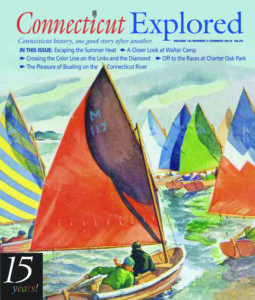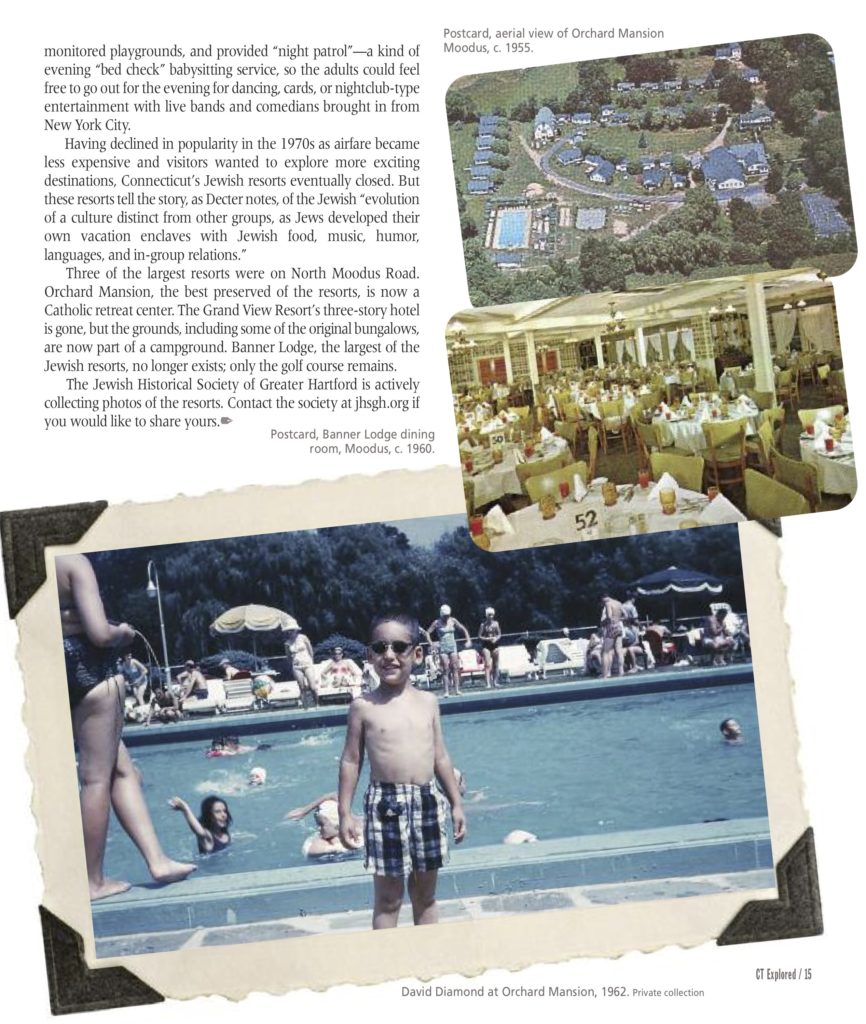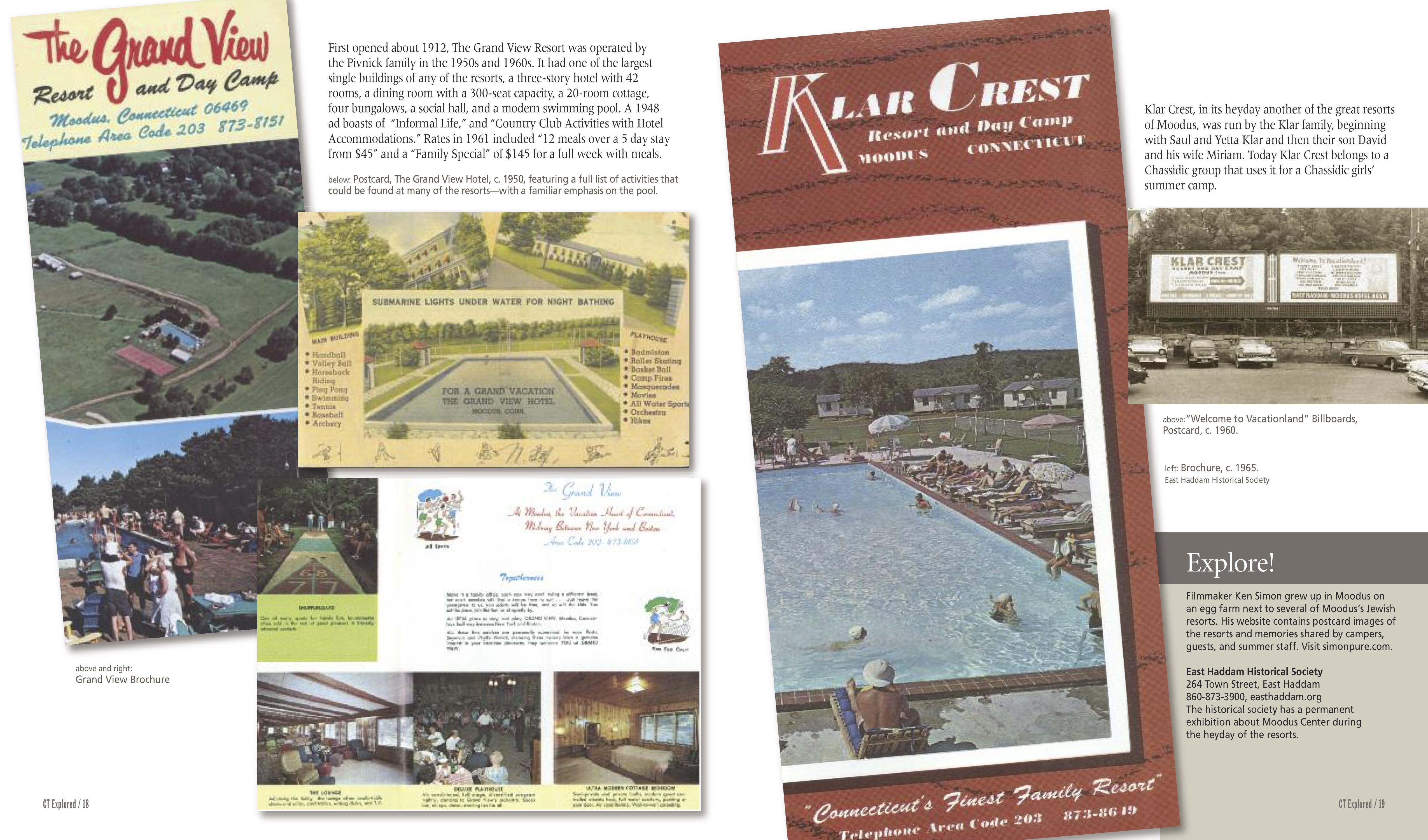All images courtesy of Mary M. Donohue unless otherwise noted.
(c) Connecticut Explored Inc. Summer 2018
Subscribe/Buy the Issue
From the beginning of the 20th century through the 1970s, Jewish families came to Connecticut looking for rest and relaxation in the countryside. Before World War II, in particular, Jewish workers in New York City had few options for escaping the summer heat. In searching for vacation spots they had to read the ads in the local paper carefully. A typical classified-ad page in 1924 in The Brooklyn (New York) Daily Eagle, for example, featured Connecticut resorts that touted home cooking, fresh vegetables, and a restful country atmosphere. But upon close inspection, some ads specified “Gentile” or “Gentile Preferred,” making it clear that Jewish vacationers were not welcome. Ads in the 1930s and 1940s read “Christian house” or “near churches” to convey the same message.
 As in upstate New York, Connecticut sprouted its own resorts to cater to a Jewish clientele. Entrepreneurial Jewish resort proprietors such as Sam Fast of The Grand View Hotel in Moodus, established in 1912, added “kosher home cooking” to their ads to let Jewish readers know that they would be welcome. As Avi Decter notes in The Other Promised Land: Vacationing, Identity and the Jewish American Dream (The Jewish Museum of Maryland, 2005), “Jewish Americans were vacation pioneers. They were among the first American ethnics to promote vacations for the working class, aided by the fact that many worked in the needle trades whose factories and workshops shut down for a time each summer… [in places like the]Catskills, they provided traditional foods, observed the Sabbath and the festivals … [and]organized synagogues while enabling Jewish travelers to fulfill their American aspirations.”
As in upstate New York, Connecticut sprouted its own resorts to cater to a Jewish clientele. Entrepreneurial Jewish resort proprietors such as Sam Fast of The Grand View Hotel in Moodus, established in 1912, added “kosher home cooking” to their ads to let Jewish readers know that they would be welcome. As Avi Decter notes in The Other Promised Land: Vacationing, Identity and the Jewish American Dream (The Jewish Museum of Maryland, 2005), “Jewish Americans were vacation pioneers. They were among the first American ethnics to promote vacations for the working class, aided by the fact that many worked in the needle trades whose factories and workshops shut down for a time each summer… [in places like the]Catskills, they provided traditional foods, observed the Sabbath and the festivals … [and]organized synagogues while enabling Jewish travelers to fulfill their American aspirations.”
Many of Connecticut’s summer accommodations for Jewish vacationers were on farms—an early form of agri-tourism. (See “Hebrew Tillers of the Soil,” Spring 2006.) Often hosting family members at first, boardinghouses and hotels for Jewish visitors could be found in small farming communities such as Chesterfield or Mansfield in eastern Connecticut by the second decade of the 20th century. In Mansfield, the Ostrovsky family, immigrants from Russia, built the Storrs Hotel, a large, wooden, gabled building with a wrap-around veranda, in 1914. New scholarship has documented the Jewish resort trade in the neighboring communities of Sharon, Connecticut and Armenia, New York. The income from such ventures proved essential to farmers across the state, and over time some Jewish farmers developed thriving resorts in Colchester, Moodus, and Lebanon.
By the 1950s and 1960s Jewish vacationers arrived by car to resorts in Connecticut. Simple activities such as swimming, boating, and visiting small-town shops were now augmented by golf, tennis, dancing, and nightclub entertainment. Before World War II, some vacationers took advantage of the “koch-a-lein,” an arrangement in which the guests cooked for themselves in the farm or summer kitchen. But by the 1950s large resorts like Orchard Mansion or Banner Lodge served hundreds of meals a day. Most resorts had an “all you can eat” policy, and Jewish resorts, while not necessarily kosher, advertised “Jewish American cuisine.”
Moodus developed the largest concentration of resorts that catered to Jews. In July 1953 The Brooklyn Daily Eagle ran a full-page travel story headlined “Varied Joys of Vacation Lands Thrill Brooklynites,” featuring photos of family recreation at various Moodus resorts. “Baby Boomer” families flocked to resorts where social directors arranged activities for children, monitored playgrounds, and provided “night patrol”—a kind of evening “bed check” babysitting service, so the adults could feel free to go out for the evening for dancing, cards, or nightclub-type entertainment with live bands and comedians brought in from New York City.
Having declined in popularity in the 1970s as airfare became less expensive and visitors wanted to explore more exciting destinations, Connecticut’s Jewish resorts eventually closed. But these resorts tell the story, as Decter notes, of the Jewish “evolution of a culture distinct from other groups, as Jews developed their own vacation enclaves with Jewish food, music, humor, languages, and in-group relations.”
Three of the largest resorts were on North Moodus Road. Orchard Mansion, the best preserved of the resorts, is now a Catholic retreat center. The Grand View Resort’s three-story hotel is gone, but the grounds, including some of the original bungalows, are now part of a campground. Banner Lodge, the largest of the Jewish resorts, no longer exists; only the golf course remains.
(above) In 1926 Sam Banner of East Haddam purchased 135 acres in North Moodus through the Jewish Agricultural & Industrial Aid Society. The original farm became the famous Banner Lodge resort. In 1935, the property transferred to Jack Banner. During the “Red Scare” of the 1950s, when scores of entertainers were blacklisted because of their alleged connection to leftist politics or Communism, Banner hired blacklisted Hollywood and Broadway star Zero Mostel, Banner’s first cousin, to perform weekly shows during the summer season. Packed houses helped Mostel during a time when work for him was scarce. (TheHartford Courant, November 24, 1979)
Large, modern pools were a huge draw at the resorts. “…We have added plenty of chaise lounges around our Olympic pool,” Banner Lodge advertised, “plus a modernistic outdoor stage for afternoon dance fests and museum siestas. Whether you want to play or relax, your choice is here…Sincerely, The Banners”
(above left) First opened about 1912, The Grand View Resort was operated by the Pivnick family in the 1950s and 1960s. It had one of the largest single buildings of any of the resorts, a three-story hotel with 42 rooms, a dining room with a 300-seat capacity, a 20-room cottage, four bungalows, a social hall, and a modern swimming pool. An ad in 1948 boasts of “Informal Life,” and “Country Club Activities with Hotel Accommodations.” Rates in 1961 included “12 meals over a 5 day stay from $45” and a “Family Special” of $145 for a full week with meals.
(above right) Klar Crest, in its heyday another of the great resorts of Moodus, was run by the Klar family, beginning with Saul and Yetta Klar and then their son David and his wife Miriam Klar. Today, Klar Crest belongs to a Chassidic group that uses it for a Chassidic girls’ summer camp.
The Jewish Historical Society of Greater Hartford is actively collecting photos of the resorts. Contact the society at jhsgh.org if you would like to share yours.
Mary M. Donohue is assistant publisher of Connecticut Explored. She is the co-author of A Life of the Land: Connecticut’s Jewish Farmers (Jewish Historical Society of Greater Hartford, 2010) and a frequent contributor to Connecticut Explored and our podcast Grating the Nutmeg.
Explore!
Filmmaker Ken Simon grew up in Moodus on an egg farm next to several of Moodus’s Jewish resorts. His website contains postcard images of the resorts and memories shared by campers, guests, and summer staff. Visit simonpure.com.
East Haddam Historical Society
264 Town Street, East Haddam
860-873-3900, easthaddam.org
The historical society has a permanent exhibition about Moodus Center during the heyday of the resorts.



